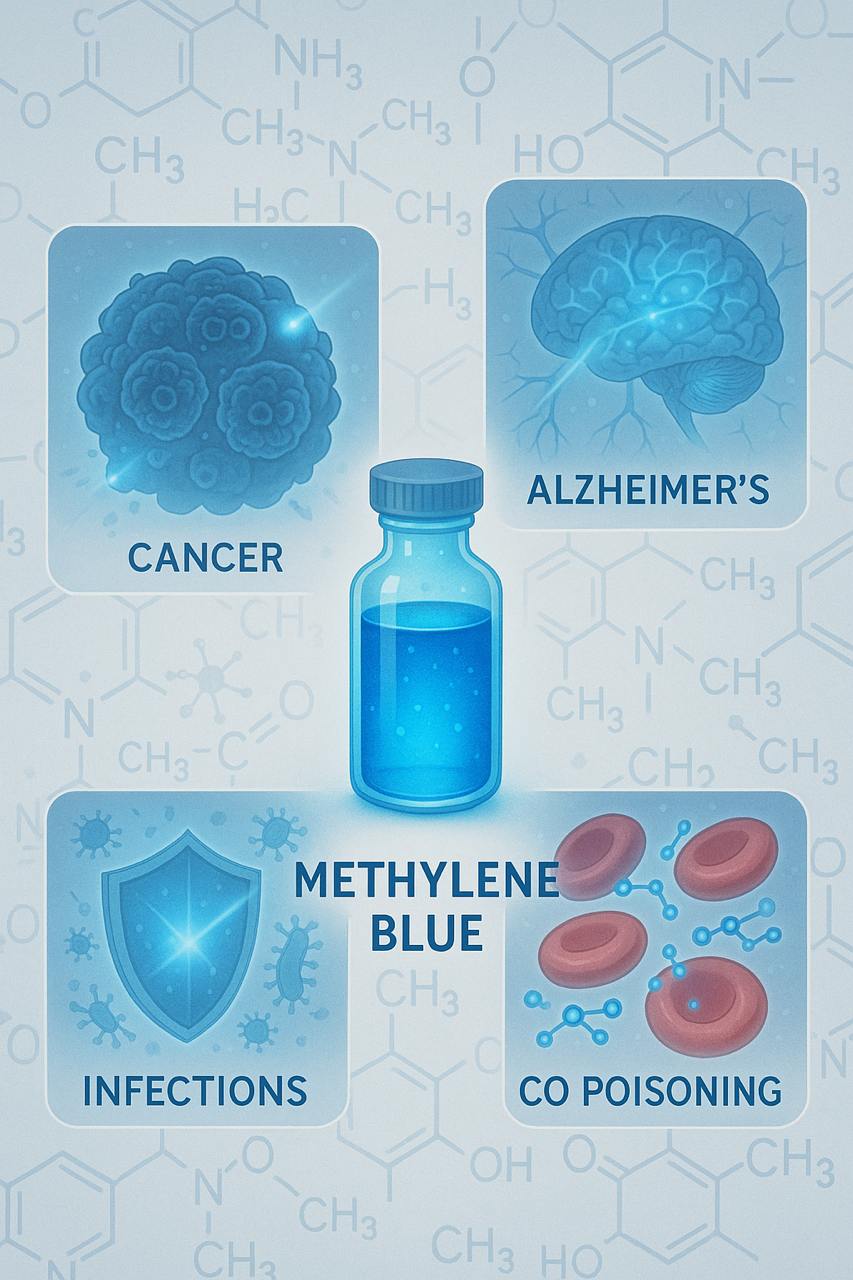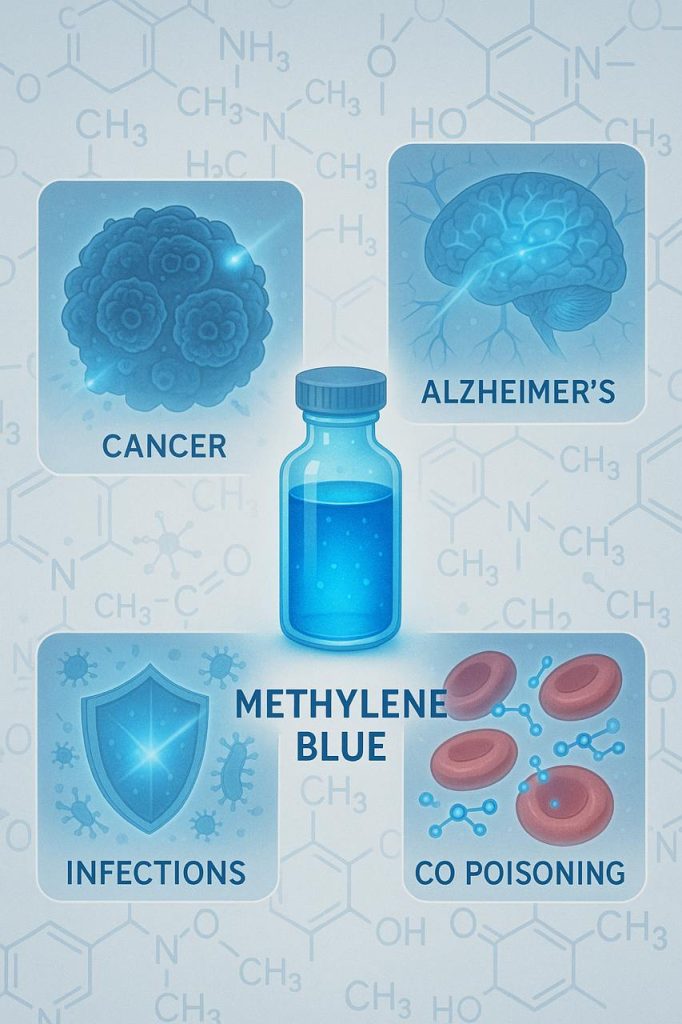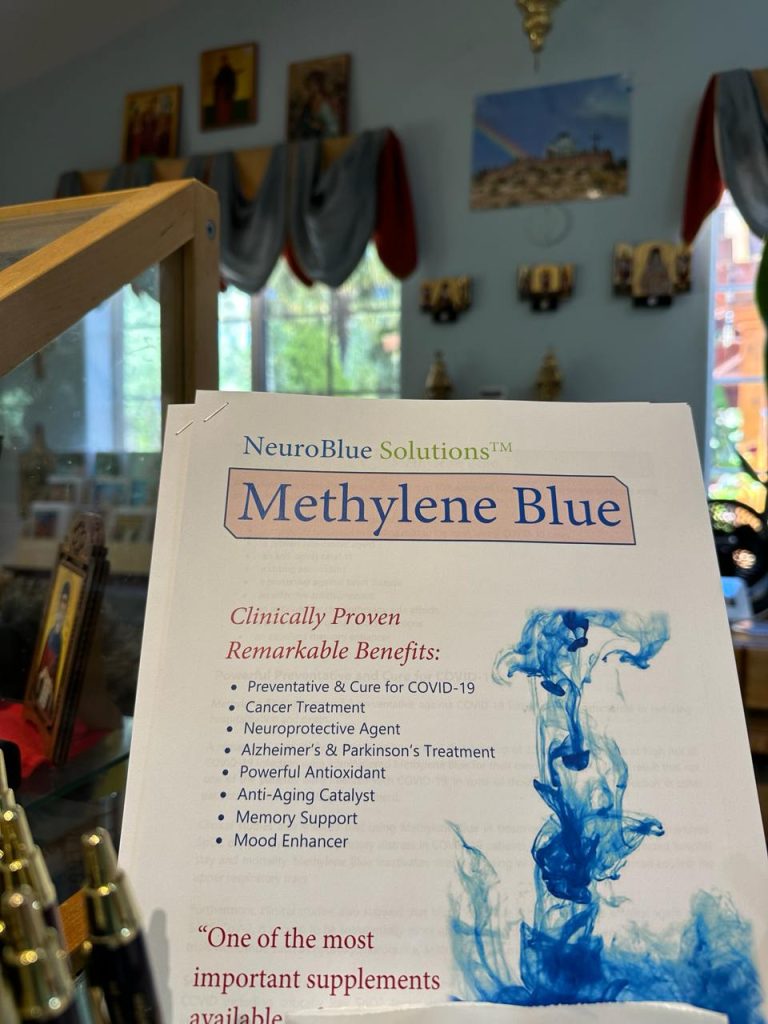
When I was a child in the Yaroslavl region of the Soviet Union, our healthcare system was remarkably effective—decades ahead of its time. Many standard practices we took for granted are now being “rediscovered” by biohackers and integrative medicine clinics in the U.S. and Europe. These “Russian” roots are increasingly recognized at biohacking conferences, particularly in light, ultrasound, and laser therapies, hyperbaric chambers, infrared saunas, ozone cocktails, bioactive peptides, and “live” and “dead” water, among others. Many unique biophysics-based biohacking devices are still manufactured in Russia or replicated worldwide. Each of these modalities deserves its own post—in due time.

Back then, we didn’t have many chemical drugs. For us kids, the two most ubiquitous remedies were Zelenka (brilliant green) and Sin’ka (methylene blue, or MB). Zelenka was the go-to antiseptic for everything external—wounds, cuts, insect bites, splinters, and blisters. Methylene blue could also be used externally but was mostly applied internally—for smearing throat infections with a cotton swab, treating urinary tract infections, or fighting skin and nail fungal infections. It was even used casually for cleaning aquarium water. Methylene blue was efficient and harmless, except for coloring urine blue and staining toenails.
I forgot about MB for decades. It was never casually used during my 25 years in the U.S., nor was it prescribed by doctors. But a few years ago, quite suddenly, MB was “rediscovered” as a universal miracle drug—a panacea for everything from cancer to dementia. Amazon now lists more than 150 books with titles like MB Healing Bible, MB Power, The Molecule That Can Save Your Life, and MB Biohackers’ Ultimate Guide. MB has become a staple at biohacking shows, a common tool in nutritionists’ protocols, and even appears on premium eye-level shelves in organic food shops. My personal favorite was spotting MB bottles alongside crosses, icons, and religious texts at the Saint Anthony’s Greek Orthodox Monastery in Arizona. Today, MB is used far beyond its original antiseptic and aquarium applications.

So what happened—and what makes methylene blue the #1 remedy for everything? Its molecular formula is C₁₆H₁₈ClN₃S. Chemically, it’s a heterocyclic aromatic dye from the phenothiazine family. It was first synthesized in 1876 by Heinrich Caro, a chemist at BASF. In the 1880s, microbiologist Paul Ehrlich discovered its antibacterial and antiparasitic properties and used it as the first synthesized anti-malarial drug. Today, MB is widely used in both conventional and integrative medicine for various applications:
- Mitochondrial health and antioxidant effects:
MB can function as an alternative electron carrier in the mitochondrial electron transport chain—a key process for ATP (adenosine triphosphate) production, our main energy source. In cases of mitochondrial dysfunction (chronic fatigue syndrome, autoimmune diseases, cancer, etc.), MB helps support energy production and membrane repair. - Reduction of oxidative stress:
By donating electrons, MB helps reduce reactive oxygen species (ROS), minimizing oxidative damage. - Neuroprotection:
MB crosses the blood-brain barrier, protects neurons from oxidative stress, and enhances memory. It is currently in clinical trials for Alzheimer’s disease. - Methemoglobinemia therapy:
MB is FDA-approved for treating carbon monoxide (CO) poisoning. CO binds to iron in hemoglobin, converting Fe²⁺ to Fe³⁺ and rendering it unable to carry oxygen. MB reverses this by reducing Fe³⁺ back to Fe²⁺. Every emergency room in the U.S. is stocked with high-dose sterile MB ampoules for this purpose. - Anti-infective applications:
This was MB’s original purpose, and it remains highly effective. It has been used as an anti-COVID-19 alternative. At Santa Maria, we use intravenous MB to treat urinary tract infections, particularly in women. We start with urine analysis and follow up with cultures if infection is detected. In many cases, pathogens like E. coli, Enterobacter, Streptococcus, and Pseudomonas aeruginosa are resistant to multiple antibiotics—or all tested antibiotics. Yet, 3–4 IV treatments with MB consistently eliminate the infection, regardless of resistance or whether the bacteria are Gram-positive or Gram-negative. Recently, MB was added to the arsenal of leading European Lyme disease clinics as a highly effective anti-Borrelia therapy.
MB’s anti-infective effects are especially potent when activated by red light or laser—a process known as photodynamic therapy (PDT). MB acts as a photosensitizer, absorbing light energy and converting it into ROS (e.g., singlet oxygen, ¹O₂), which damage microbial cells. PDT with MB is currently being studied for a wide range of chronic illnesses.
Safety and Side Effects
Methylene blue is generally safe. Most patients experience no discomfort other than temporary blue urine for 2–3 days. However, some may feel a burning sensation during red light activation when administered intravenously. It can also be toxic for patients with G6PD deficiency, as it may trigger hemolytic anemia.
MB may interact negatively with certain medications, especially SSRIs (selective serotonin reuptake inhibitors). Combined use can lead to insomnia, anxiety, and overstimulation. Doctors should always review a patient’s medication and supplement list before administering MB and consult drug-interaction databases like Medscape.
Conclusion
Methylene blue is one of the most potent and versatile synthetic compounds in medicine. Its therapeutic benefits far outweigh its rare and manageable side effects. We look forward to further discoveries—especially in its photoactivated form—that expand the therapeutic potential of this extraordinary molecule.
